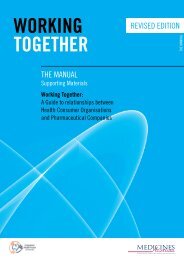Transition in Chronic Illness - Understanding Transition
Transition in Chronic Illness - Understanding Transition
Transition in Chronic Illness - Understanding Transition
- No tags were found...
You also want an ePaper? Increase the reach of your titles
YUMPU automatically turns print PDFs into web optimized ePapers that Google loves.
Our Message To YouLearn<strong>in</strong>g to live with chronic illness is an ongo<strong>in</strong>g complex personal process. Sometimes the watersare smooth sail<strong>in</strong>g and at other times it can seem like never end<strong>in</strong>g disruption. Sometimes thewaters are murky and it is difficult to see our way forward, and at other times the waters are clearand we feel like we have control of our journey. The experience of illness is constantly shift<strong>in</strong>g. Begentle with yourself and allow for the ups and downs. Remember that it will not always be this way.Eventually we transition to a sense of order once more. Even when disruptions cont<strong>in</strong>ue to occur,the impact is m<strong>in</strong>imised because we have developed resilience and the skills we need to workthrough difficult times and bounce back. Negotiat<strong>in</strong>g the <strong>in</strong>itial transition is no small feat. It is alife chang<strong>in</strong>g process, which requires personal resources, balance and courage. Our understand<strong>in</strong>gof the process that people go through after chronic illness strikes is based on the stories andexperiences of many people liv<strong>in</strong>g with chronic illness. It is useful to understand your experienceas a process of personal transition and one which despite be<strong>in</strong>g chaotic at times will lead to youreclaim<strong>in</strong>g a sense of liv<strong>in</strong>g an ord<strong>in</strong>ary life.Our Message To Health WorkersWe need support to transition through times of disruption and you are ideally placed to assistus. Help us to share our difficult times by walk<strong>in</strong>g with us through the ‘look, th<strong>in</strong>k and actprocess’. Dur<strong>in</strong>g this process we need you to be with us rather than judg<strong>in</strong>g us. Br<strong>in</strong>g a will<strong>in</strong>gnessto sit beside us and listen, try to understand our experience, and to f<strong>in</strong>d places where yourunderstand<strong>in</strong>gs can enhance our well be<strong>in</strong>g and our ability to manage illness. Perhaps you havefound different tools and techniques than the ones we have used. Offer these as suggestionsrather than prescriptions. Be patient because <strong>in</strong>corporat<strong>in</strong>g change <strong>in</strong>to our lives takes time.The process of sett<strong>in</strong>g “self care” goals with those of us who are learn<strong>in</strong>g to live with chronic illnesscan <strong>in</strong>volve three steps.1. Look… Explore and def<strong>in</strong>e the issue. Rather than beg<strong>in</strong>n<strong>in</strong>g the encounter focused on test resultsbeg<strong>in</strong> by say<strong>in</strong>g, “Tell me what concerns you most. Tell me what is hardest for you. Tell me whatyou’re most distressed about and what you’d most like to change.”2. Th<strong>in</strong>k… When you beg<strong>in</strong> to get a sense of our concerns, use open ended questions to explorethose issues with us. Ask, “Can you th<strong>in</strong>k of any other reasons why you might be feel<strong>in</strong>g this way?Are there other th<strong>in</strong>gs that might be happen<strong>in</strong>g which may be contribut<strong>in</strong>g to this issue? Whendoes this happen? How do you react to the issue when it happens? How do other significant peoplereact?20<strong>Transition</strong> <strong>in</strong> <strong>Chronic</strong> <strong>Illness</strong> | Booklet 11 | Understand<strong>in</strong>g <strong>Transition</strong>















